共享汽车 car-sharing
- 格式:docx
- 大小:13.99 KB
- 文档页数:1
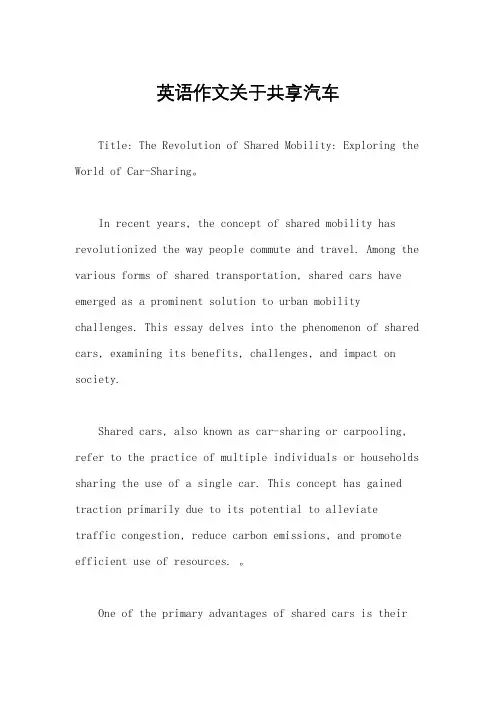
英语作文关于共享汽车Title: The Revolution of Shared Mobility: Exploring the World of Car-Sharing。
In recent years, the concept of shared mobility has revolutionized the way people commute and travel. Among the various forms of shared transportation, shared cars have emerged as a prominent solution to urban mobility challenges. This essay delves into the phenomenon of shared cars, examining its benefits, challenges, and impact on society.Shared cars, also known as car-sharing or carpooling, refer to the practice of multiple individuals or households sharing the use of a single car. This concept has gained traction primarily due to its potential to alleviatetraffic congestion, reduce carbon emissions, and promote efficient use of resources. 。
One of the primary advantages of shared cars is theircontribution to reducing traffic congestion in urban areas. By enabling multiple individuals to share a single vehicle for their daily commutes or occasional trips, car-sharing helps decrease the number of vehicles on the road. This, in turn, leads to less traffic congestion, shorter travel times, and improved overall efficiency of transportation systems.Furthermore, shared cars play a significant role in promoting environmental sustainability by reducing the carbon footprint associated with private vehicle ownership. Studies have shown that shared mobility services result in lower emissions per capita compared to traditional car ownership models. By encouraging people to share rides and utilize vehicles more efficiently, shared cars contribute to mitigating air pollution and combating climate change.Additionally, shared cars offer economic benefits to both users and society as a whole. Individuals who participate in car-sharing programs can save money on fuel, maintenance, and parking expenses, as they share the costs with other users. Moreover, shared mobility services canlead to reduced demand for private vehicle ownership, resulting in lower overall spending on transportation infrastructure and maintenance by governments and municipalities.Despite its numerous advantages, the widespread adoption of shared cars faces several challenges. One of the primary concerns is the issue of trust and reliability among users. Participants in car-sharing programs musttrust each other to adhere to scheduling agreements, maintain the cleanliness and condition of the vehicle, and follow safety protocols. Building trust among users and establishing reliable mechanisms for resolving conflicts are essential aspects of ensuring the success of shared mobility initiatives.Another challenge is the need for robust infrastructure and technological support to facilitate seamless car-sharing experiences. This includes developing user-friendly mobile applications for booking and accessing shared vehicles, implementing efficient vehicle tracking and monitoring systems, and establishing designated parking andpick-up/drop-off locations for shared cars. Governments, private companies, and other stakeholders must collaborateto invest in and develop the necessary infrastructure to support the growth of shared mobility services.Furthermore, the regulatory environment surrounding shared cars can pose obstacles to their widespread adoption. Issues such as insurance coverage, liability, and compliance with local transportation regulations need to be addressed to ensure the legality and safety of car-sharing operations. Policymakers must work closely with industry stakeholders to develop clear and consistent regulatory frameworks that promote innovation while safeguarding the interests of consumers and the public.In conclusion, shared cars represent a promisingsolution to the challenges of urban mobility, offering numerous benefits in terms of reducing traffic congestion, lowering carbon emissions, and promoting economic efficiency. However, realizing the full potential of shared mobility requires addressing various challenges related to trust, infrastructure, and regulation. By overcoming thesehurdles through collaboration and innovation, we can unlock the transformative power of shared cars and create more sustainable and accessible transportation systems forfuture generations.。
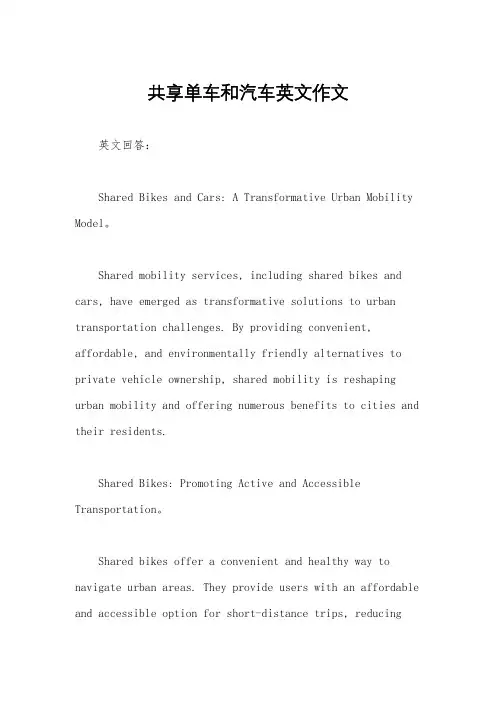
共享单车和汽车英文作文英文回答:Shared Bikes and Cars: A Transformative Urban Mobility Model。
Shared mobility services, including shared bikes and cars, have emerged as transformative solutions to urban transportation challenges. By providing convenient, affordable, and environmentally friendly alternatives to private vehicle ownership, shared mobility is reshaping urban mobility and offering numerous benefits to cities and their residents.Shared Bikes: Promoting Active and Accessible Transportation。
Shared bikes offer a convenient and healthy way to navigate urban areas. They provide users with an affordable and accessible option for short-distance trips, reducingtraffic congestion and promoting active transportation. Moreover, shared bikes cater to a wide range of users, including commuters, students, and tourists, enhancing accessibility and mobility within cities.Shared Cars: Flexible and Sustainable Transportation。
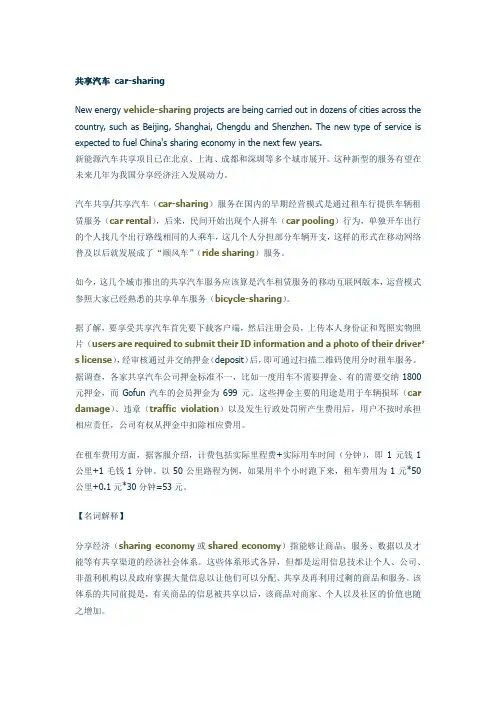
共享汽车car-sharingNew energy vehicle-sharing projects are being carried out in dozens of cities across the country, such as Beijing, Shanghai, Chengdu and Shenzhen. The new type of service is expected to fuel China's sharing economy in the next few years.新能源汽车共享项目已在北京、上海、成都和深圳等多个城市展开。
这种新型的服务有望在未来几年为我国分享经济注入发展动力。
汽车共享/共享汽车(car-sharing)服务在国内的早期经营模式是通过租车行提供车辆租赁服务(car rental),后来,民间开始出现个人拼车(car pooling)行为,单独开车出行的个人找几个出行路线相同的人乘车,这几个人分担部分车辆开支,这样的形式在移动网络普及以后就发展成了“顺风车”(ride sharing)服务。
如今,这几个城市推出的共享汽车服务应该算是汽车租赁服务的移动互联网版本,运营模式参照大家已经熟悉的共享单车服务(bicycle-sharing)。
据了解,要享受共享汽车首先要下载客户端,然后注册会员,上传本人身份证和驾照实物照片(users are required to submit their ID information and a photo of their driver’s license),经审核通过并交纳押金(de p osit)后,即可通过扫描二维码使用分时租车服务。
据调查,各家共享汽车公司押金标准不一,比如一度用车不需要押金、有的需要交纳1800元押金,而Gofun汽车的会员押金为699元。
这些押金主要的用途是用于车辆损坏(car damage)、违章(traffic violation)以及发生行政处罚所产生费用后,用户不按时承担相应责任,公司有权从押金中扣除相应费用。

共享汽车的发展历程随着城市化进程的加快,交通拥堵和环境污染等问题逐渐凸显,共享经济的兴起为解决这些问题提供了新的思路和解决方案。
共享汽车作为共享经济的重要组成部分,经历了从无到有、从小众到普及的发展历程。
共享汽车最早可以追溯到上世纪60年代的欧洲,当时一些社区或组织开始尝试共享私家车辆,以解决交通问题。
然而,由于当时技术条件和社会环境的限制,这种尝试并没有取得很大的成功。
直到近年来,随着智能手机和移动互联网的普及,共享经济迅速发展起来,共享汽车也迎来了历史性的机遇。
2010年,美国出现了第一家以共享汽车为主营业务的公司Zipcar,开启了共享汽车的商业化运营模式。
随着共享汽车概念的引入,越来越多的创业者开始投身于这一领域。
2012年,中国共享汽车领域的第一支军团——盼达用车成立,开创了中国共享汽车的先河。
紧随其后,摩拜单车、ofo、滴滴出行等企业也相继推出了共享汽车服务,进一步推动了共享汽车的发展。
2014年,北京市率先出台了《关于促进汽车租赁行业健康发展的若干意见》,提出支持发展共享汽车,推动绿色出行的发展。
此后,全国各地相继出台了相关政策,为共享汽车的发展提供了政策保障。
共享汽车的发展并非一帆风顺。
在初期阶段,由于用户对共享汽车的认知度不高、停车位不足等问题,共享汽车的推广受到了一定的阻碍。
此外,共享汽车的盈利模式也面临着挑战,许多共享汽车企业纷纷陷入亏损的困境。
然而,共享汽车的发展势头并未受到影响,相反,它在经历了初期的试错和调整后逐渐走上了正轨。
共享汽车的用户数量逐年增加,覆盖的城市范围也在不断扩大。
同时,随着技术的不断进步,共享汽车的预定、取还车等操作也变得更加便捷和智能化。
2017年,共享汽车迎来了快速发展的高峰期。
滴滴出行宣布投放10万辆共享汽车,摩拜单车与特斯拉合作推出了共享电动汽车,共享汽车行业进入了全新的阶段。
随着共享汽车的普及,人们的出行方式也发生了改变。
以往主要依靠私家车或公共交通工具的出行模式逐渐转变为多元化的出行选择。
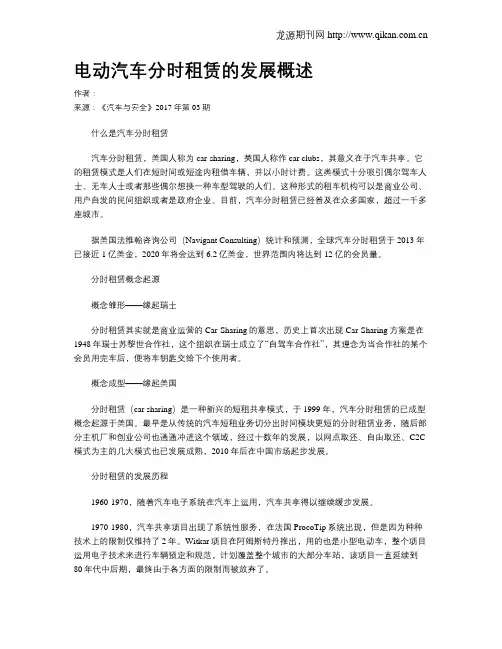
电动汽车分时租赁的发展概述作者:来源:《汽车与安全》2017年第03期什么是汽车分时租赁汽车分时租赁,美国人称为car-sharing,英国人称作car clubs,其意义在于汽车共享。
它的租赁模式是人们在短时间或短途内租借车辆,并以小时计费。
这类模式十分吸引偶尔驾车人士、无车人士或者那些偶尔想换一种车型驾驶的人们。
这种形式的租车机构可以是商业公司、用户自发的民间组织或者是政府企业。
目前,汽车分时租赁已经普及在众多国家,超过一千多座城市。
据美国法维翰咨询公司(Navigant Consulting)统计和预测,全球汽车分时租赁于2013年已接近1亿美金,2020年将会达到6.2亿美金,世界范围内将达到12亿的会员量。
分时租赁概念起源概念雏形——缘起瑞士分时租赁其实就是商业运营的Car-Sharing的意思,历史上首次出现Car-Sharing方案是在1948年瑞士苏黎世合作社,这个组织在瑞士成立了“自驾车合作社”,其理念为当合作社的某个会员用完车后,便将车钥匙交给下个使用者。
概念成型——缘起美国分时租赁(car sharing)是一种新兴的短租共享模式,于1999年,汽车分时租赁的已成型概念起源于美国。
最早是从传统的汽车短租业务切分出时间模块更短的分时租赁业务,随后部分主机厂和创业公司也通通冲进这个领域,经过十数年的发展,以网点取还、自由取还、C2C 模式为主的几大模式也已发展成熟,2010年后在中国市场起步发展。
分时租赁的发展历程1960-1970,随着汽车电子系统在汽车上运用,汽车共享得以继续缓步发展。
1970-1980,汽车共享项目出现了系统性服务,在法国ProcoTip系统出现,但是因为种种技术上的限制仅维持了2年。
Witkar项目在阿姆斯特丹推出,用的也是小型电动车,整个项目运用电子技术来进行车辆预定和规范,计划覆盖整个城市的大部分车站,该项目一直延续到80年代中后期,最终由于各方面的限制而被放弃了。
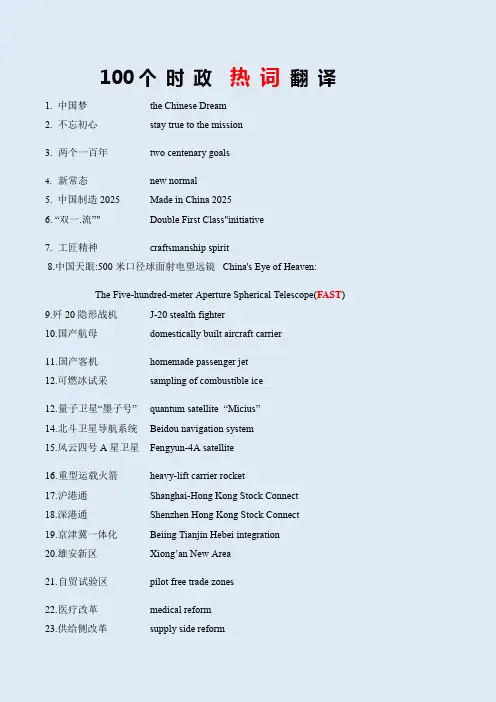
100个时政热词翻译1. 中国梦the Chinese Dream2. 不忘初心stay true to the mission3.两个一百年two centenary goals4.新常态new normal5. 中国制造2025Made in China20256. “双一.流”"Double First Class"initiative7.工匠精神craftsmanship spirit8.中国天眼:500米口径球面射电望远镜China's Eye of Heaven:The Five-hundred-meter Aperture Spherical Telescope(FAST)9.歼20隐形战机J-20stealth fighter10.国产航母domestically built aircraft carrier11.国产客机homemade passenger jet12.可燃冰试采sampling of combustible ice12.量子卫星“墨子号”quantum satellite“Micius”14.北斗卫星导航系统Beidou navigation system15.风云四号A星卫星Fengyun-4A satellite16.重型运载火箭heavy-lift carrier rocket17.沪港通Shanghai-Hong Kong Stock Connect18.深港通Shenzhen Hong Kong Stock Connect19.京津冀一体化Beiing Tianjin Hebei integration20.雄安新区Xiong’an New Area21.自贸试验区pilot free trade zones22.医疗改革medical reform23.供给侧改革supply side reform23.扫脸支付face scan payment25.二维码支付two -dimensional barcode payment26.人工智能(A.I.) artificial intelligence27.虚拟现实(VR.)virtual reality28.5G时代5G era29.分享经济sharing economy30.互联网金融online finance31.亚投行Asia Infrastructure Investment Bank32.低碳城市low carbon cities33.一小时通勤圈one hour commuting circle34.蓝色经济blue economy35.纵向横向经济轴带north-south and east-west intersecting economic belts36.众创、众包、众扶、众筹crowd innovation,crowdsourcing,crowd support and crowdfunding37.战略性新兴产业emerging sectors of:strategic importance38.香港回归祖国20周年the20th anniversary of Hong Kong’s return to China.39.点赞give a like40.自媒体We-Media41.实名认证real-name authentication41.精准扶贫targeted poverty reduction42.精准医疗precision medicine44.利益共同体community of shared interests45.轨道交通rail traffic46.动车bullet train47.城际列车inter city train48.“带一路”倡议Belt and Road Initiative49.“丝绸之路经济带”the Silk Road Eco-nomic Belt。
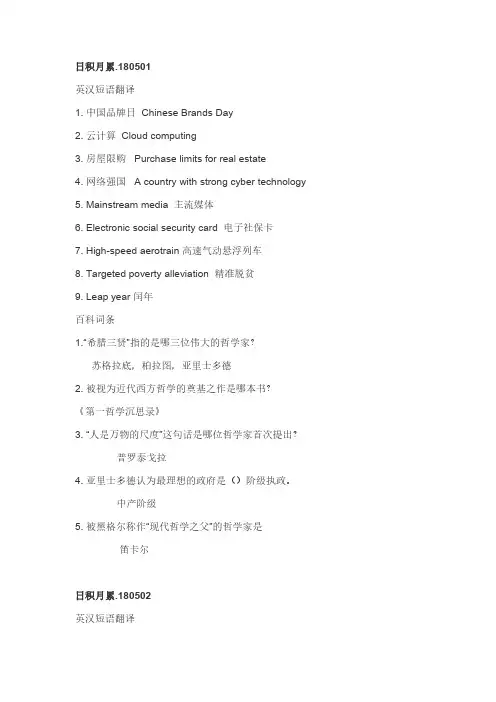
日积月累.180501英汉短语翻译1.中国品牌日Chinese Brands Day2.云计算Cloud computing3.房屋限购Purchase limits for real estate4.网络强国A country with strong cyber technology5.Mainstream media主流媒体6.Electronic social security card电子社保卡7.High-speed aerotrain高速气动悬浮列车8.Targeted poverty alleviation精准脱贫9.Leap year闰年百科词条1.“希腊三贤”指的是哪三位伟大的哲学家?苏格拉底,柏拉图,亚里士多德2.被视为近代西方哲学的奠基之作是哪本书?《第一哲学沉思录》3.“人是万物的尺度”这句话是哪位哲学家首次提出?普罗泰戈拉4.亚里士多德认为最理想的政府是()阶级执政。
中产阶级5.被黑格尔称作“现代哲学之父”的哲学家是笛卡尔日积月累.180502英汉短语翻译1.大众创新,万众创业mass entrepreneurship and innovation2.虚拟现实Virtual Reality(VR)3.新时代中国特色社会主义socialism with Chinese characterism in a new era4.孔子学院Confucius Institute5.网红经济Internet celebrity economy6.dynamic equivalence动态对等7.back translation回译8.fight corruption and build a clean government反腐倡廉9.CAT计算机辅助翻译10.to teach fish to swim班门弄斧日积月累.180503英汉短语翻译隐形贫困人口the invisible poverty-stricken population/the invisible poor国家安全意识the national security awareness政府集中采购centralized government procurement比特币Bitcoin人工智能artificial intelligenceharmony without uniformity和而不同zero-sum mentality零和博弈ppp政府和社会资本合作(public-private partnership)bond default债券违约Translationese翻译腔日积月累.180504英汉短语翻译1.三大攻坚战three tough battles2.征税清单tariff list3.人才争夺战talent scramble battle4.全面二胎政策the universal second-child policy5.军事分界线military demarcation line(MDL)6.QR code快速响应矩阵码7.sponge city海绵城市8.IPO首次公开募股9.autonomous driving technology自动驾驶技术10.Onomatopoeia拟声法百科知识1.下列我国哪个古迹被誉为“世界八大奇迹”(C)A.万里长城B.乐山大佛C.秦始皇兵马俑D.敦煌2.石头城是对我国哪座城市的美称(B)A.南昌B.南京C.拉萨D.西安3.请问:火车连续发出两声长鸣,这表示(C)A.前进B.停留C.倒退D.故障4.我国第一座国家森林公园是(C)A.武夷山B.长白山C.张家界D.九寨沟5.我国古代“十恶不赦”中的首恶是(D)A.不义B.不道C.内乱D.谋反日积月累.150505英汉短语翻译新一线城市new first-tier city暂定税率provisional tax rate十九大the19th National Congress of the Communist Party of China(CPC)朝鲜半岛无核化denuclearization of the Korean Peninsula长江考察trip along the Yangtze Riverthe six-party talks六方会谈Island-wide quota policy全域限购政策SOHO小型家居办公literal translation字面翻译;直译over-translation超额翻译日积月累.180507英汉短语翻译1.公积金provident fund2.综合国力comprehensive national strength3.人脸识别facial recognition4.物联网the Internet of Things(IoT)5.移动支付mobile payment6.一带一路the Belt and Road7.电子商务e-commerce8.限购令limited purchasing order9.自主知识产权Independent Intellectual Property Rights10.马克思主义Marxism11.birth defect出生缺陷12.live within their means量入为出13.programmer motivator程序员鼓励师14.rural vitalization strategy乡村振兴战略15.bilateral interpreting双边传译16.covert translation隐形翻译17.double First-Class initiative双一流18.CTO首席技术官19.VAT增值税20.APEC亚太经合组织百科知识:1.第一次世界大战的开战时间是(B)A.1910B.1914C.1939D.19402.下列农民起义哪次是洪秀全领导的(D)A.大泽乡起义B.黄巾起义C.赤眉起义D.金田起义3.下列清朝皇帝中哪位是末代皇帝(A)A.宣统B.光绪C.同治D.道光4.中华人民共和国国旗五星红旗的设计者是(C)A.毛泽东B.周恩来C.曾联松D.梁思成5.我国最早的一部医学理论著作是(B)A.《本草纲目》B.《黄帝内经》C.《千金方》D.《伤寒杂病论》日积月累.180508英汉短语翻译1.软实力soft power2.硕士生导师supervisor of postgraduate3.人才流失brain drain4.不要在错误的道路上越走越远refrain from going further down the wrong path5.21世纪数字丝绸之路a digital silk road of21st century6.down payment首付7.demographic dividend人口红利8.two centenary goals“两个一百年”奋斗目标9.Corpora语料库10.domesticating translation归化翻译日积月累.180509英汉短语翻译1.网络安全cyberspace security2.协同发展develop in a coordinated way3.朝鲜半岛局势the situation on the Korean Peninsula4.前沿领域cutting-edge areas5.谅解备忘录memorandum of understanding6.TPP跨太平洋伙伴关系协定7.independent intellectual property rights自主知识产权8.Silk Road Spirit丝路精神9.Abusive translation滥译10.Exoticism异国情调百科知识1.我国古代诗歌史上被称为“双璧”的一篇是《孔雀东南飞》,另一篇是(A)A.《木兰诗》B.《木兰辞》C.《离骚》D.《格萨尔王》2.著名的《大卫》像是谁的作品(C)A.拉斐尔B.达.芬奇C.米开朗琪罗D.阿古斯特尔3.现在美国国旗星条旗上有多少颗星(C)A.25B.30C.50D.604.有的学校实行学分制,在我国最早提倡学分制的是(B)A.鲁迅B.蔡元培C.吴玉章D.毛泽东5.相传我国古代能作“掌上飞”的是(B)A.杨玉环B.赵飞燕C.西施D.貂蝉日积月累.180510英汉短语翻译词条1.“三步走”战略Three-Step Development Strategy2.全面建成小康社会Build a moderately prosperous society3.积分落户points-based household4.按揭贷款mortgage loans5.朝韩首脑会晤inter-Korean summit6.IMF国际货币基金组织7.public rental housing公租房8.capability of independent innovation自主创新能力9.semantic translation语义翻译10.idiomatic translation语义翻译日积月累.180512英汉短语互译1.自由贸易试验区pilot free trade zone2.近海防御offshore waters defense3.医患纠纷patient-doctor disputes4.量子通信quantum communication5.春联Spring Festival Couplets6.Negative list负面清单7.intelligent vehicles智能汽车8.THAAD末端高空区域防御系统(萨德)9.pay by installment分期支付10.the Renaissance文艺复兴日积月累.180514英汉短语互译1.交流互鉴exchanges and mutual learning2.经济全球化economic globalization3.监测网络monitoring network4.伊朗核协议Iran nuclear deal5.工匠精神craftsmanship spirit6.bubble economy泡沫经济7.special effect特效8.Ferrari法拉利9.F.I.T国际翻译工作者联合会10.arms race军备竞赛日积月累.180515英汉短语翻译1.战略沟通strategic communication2.稳中求进to make progress while ensuring stability3.基础设施建设infrastructure construction4.反倾销措施anti-dumping measures5.轮值主席rotating presidency6.FTA自由贸易协定7.leap year闰年8.health resort疗养胜地,养生度假村9.singe one's wings损害自己的名誉或利益10.cohesion and coherence衔接与连贯日积月累.180516英汉短语翻译国产航母domestically built aircraft carrier退耕还林return cultivated land to forest or pastures传销pyramid selling房子是用来住的,不是用来炒的housing is for accommodation rather than speculation中等收入陷阱middle-income traphome with joint property rights共有产权住房the Doctrine of Mean《中庸》OTC非处方药cross-border e-commerce境外电子商务vape电子烟百科知识1.“月上柳梢头,人约黄昏后。
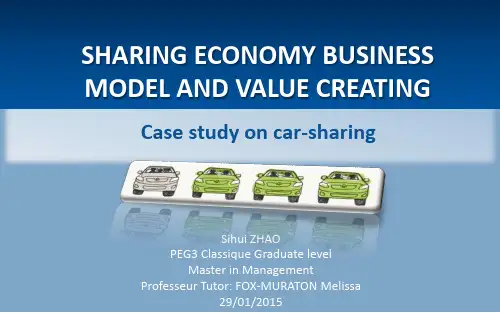
SHARING ECONOMY BUSINESS MODEL AND VALUE CREATING Case study on car-sharingSihui ZHAOPEG3 Classique Graduate levelMaster in ManagementProfesseur Tutor: FOX-MURATON Melissa29/01/2015TABLE OF CONTENT⏹ Research Context⏹ Research Objective⏹ Methodology⏹ Structure of thesis⏹ Findings⏹ ConclusionPeer-to-Peer EconomyRESEARCHCONTEXTcollaborative consumptionRelationship economyAccess EconomySharing EconomyWHAT?Economic model based on “Access to” rather than “Ownership of” physical and human assets like time, space and skills.They make use of idle assets and create new marketplaces.Sharing EconomyIn other word, it involves using online platform and internet technology as tools to connect distributed groups of people to match millions of haves with millions of needs, immediately and efficiently.MODEAIMWHERE?Sharing EconomyWHY?Peer to peer payment systems Reduced transaction costs Peer to peer social networking Innovative mobile technologiesDRIVERS OF SHARING ECONOMYIncreasing Population Density Need for more Resources Desire for community Consumerist Culture7 times more devices than people by 2020Monetize Excess or Idle InventoryIncrease Financial Flexibility Access Over Ownership Influx of VC Funding$ 2.46 billion funding inSharing economy startups in the last 7 MONTHSWorld population will be 9.3BILLION by 2050DRIVERS: T. E. S.Opportunities in Car Sharing 2020: Carsharing to emerge as additional business opportunity for automotive manufacturer for customer retention and long term sustainabilityGlobal Carsharing Outlook, Number of Members and Vehicles, 2006-2014(Source: Frost and Sullivan)Carsharing Market:Carsharing Vehicles and Members Growth, Global, 2010–2020① MemberCarsharing subscriber base to be 14 Million in EU by 2020200,000 shared vehicles expected in Europe by 2020France, United Kingdom, Germany and Switzerlandto hold around 75% of revenue share in 2016By 2016, 1 in 5 vehicles of the carsharing vehicle fleet is expected to be a battery powered EVThe revenue potential of carsharing market is expected to be €7 Billion by 2020 in EuropeVehiclePotential MarketUsage of Electric VehicleRevenue Generation⑤② ③ ④WHO?Communication technology supportCommunicationtechnology supportCUSTOMERCUSTOMER PARTICIPANTsprovides a new way of thinking about business, exchange, value and community. Enabled by internettechnologiesConnecting distributednetworks of peopleand/or assets(Mine,yours, ours)Making use of the idling capacity oftangible and intangible assetsEncouragingmeaningfulinteractions and trustEmbracing openness,inclusivity and thecommonsThe sharing economy CharacteristicsRESEARCH OBJECTS This study conducted exploratory and descriptive research on the innovation business model of Car-sharing to gain an well understanding of how such emerging consumption business model are shaped and how value creation it producesTo develop an understanding of the different between Traditional car consumption and Car-sharing consumptionmodel.To identify Car-Sharing Value Creation by NICEframeworks;To recognize the appropriate methods when applies Car-sharing value; from business, operation and customer strategyviews;Specific objectives of the study contain :M E T H O D O L O G YIntegrated Theory: Business Model Design; Value creation;Data collection; Data reduction; Data analysis;Theory StudyResearch ObjectiveEmpirical DataPrimarily problemGenerative modelBusiness model:key choices, components, ecosystem, environment, innovation elementsValue creation: Value chain,Value framework•Actors•Relationship •Mechanisms •Environment •ChallengeFind the way to answer research questions posed by the research: •What are the activities, entities, processes, and forces and the contexts that influenced, enabled, or constrained car-sharing?•What are the opportunities for the new comers to car-sharing? What the strategic options for the companies? What the market situation and thecontext of the car-sharing business?•What’s the core value of car-sharing and what the value creation model based on the car-sharing business? Who are the key players and components incarsharing business?•How to operate with outstanding execution underlying good idea? What are the correspondent strategies to figure out the challenges?S T R U C T U R E O F T H E S I SThe theory research of sharing economy development and theapplication of sharing economy business modelValue net model ofsharing economy business modelTheory studyModel frameworkBusiness modelCase studyFinding &ConclusionHow does sharing economy business model succeed in performing value creating and implementing in car-sharing business?Study ObjectiveSharing economyValue netCase studyValue creationBusiness modelstrategyValue model of car-sharing businessContextAnalysis of findings; conclusion and suggestionQuestionFINDINGFINDINGSThe car-sharing business model innovation is based on the role transformation of customers.CUSTOMERMARKETPROCESS OTHERPARTICIPANTSPRODUCT OR SERVICESOCIAL ENVIRONMENTService innovation;Potential bargain space;Collaborative consumption;Characteristics;access over ownershipBased on the internet and network terminal;No boarder of the transaction time and place;Customer driverAccurate market segmentation Car-sharing;ride-sharing; mobility-sharing;redistribution; Long life timeTransaction activity between individuals;Needs and haves self-match systemTransaction online platform;social networking services;credit supervisoryorganization; partnership;terminal manufacturerSustainable consumption;Sharing spiritCUSTOMERMARKETPROCESS OTHERPARTICIPANTSPRODUCTOR SERVICESOCIALENVIRONMENTMARKETPLACEPRODUTSSERVICEProvide a platform Company as a serviceMotivate a marketplace Sharing economyCustomer-Oriented0 0.511.522.533.544.5O f f e r i n g L e v e lCompeting Factors Traditional transportation Traditional car renting Car/Ride-sharing•Novelty- adopt innovative content, structure or governance•Lock-In – build in elements to retain business model stakeholders•Complementarities – bundle activities to generate more value•Efficiency– reorganize activities to reduce transaction costsCustomer is the core value source of the sharing economy business and it is the motivator and revolutionary of the newconsumption model.First, customer has more initiatives and each one could be the potential provider and user. Customer owns value, deliver value,create value andmaintain value.Second, Most of thecar-sharing companiesbegin to act as amediator or aplatform to match theneeds and haves.Third, the ecosystemof the car-sharingbusiness has thenature of trustestablishing.C O N CL USI ONTraditional company managers and star-ups directors, who want to share a cake in thesharing economy market, will benefit from the studyThe study’s focus on sharing economy development highlights the new consumption mode and motivates the sustainable economic seeking in the future. The sharing economy seeks to dig out the new consumption model by unlocking the value of idle and redistribution the social resources more sustainably.T H A N K S。
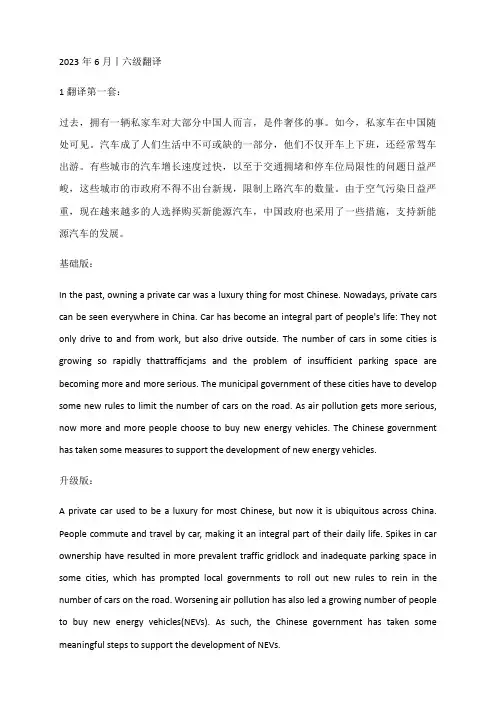
2023年6月丨六级翻译1翻译第一套:过去,拥有一辆私家车对大部分中国人而言,是件奢侈的事。
如今,私家车在中国随处可见。
汽车成了人们生活中不可或缺的一部分,他们不仅开车上下班,还经常驾车出游。
有些城市的汽车增长速度过快,以至于交通拥堵和停车位局限性的问题日益严峻,这些城市的市政府不得不出台新规,限制上路汽车的数量。
由于空气污染日益严重,现在越来越多的人选择购买新能源汽车,中国政府也采用了一些措施,支持新能源汽车的发展。
基础版:In the past, owning a private car was a luxury thing for most Chinese. Nowadays, private cars can be seen everywhere in China. Car has become an integral part of people's life: They not only drive to and from work, but also drive outside. The number of cars in some cities is growing so rapidly thattrafficjams and the problem of insufficient parking space are becoming more and more serious. The municipal government of these cities have to develop some new rules to limit the number of cars on the road. As air pollution gets more serious, now more and more people choose to buy new energy vehicles. The Chinese government has taken some measures to support the development of new energy vehicles.升级版:A private car used to be a luxury for most Chinese, but now it is ubiquitous across China. People commute and travel by car, making it an integral part of their daily life. Spikes in car ownership have resulted in more prevalent traffic gridlock and inadequate parking space in some cities, which has prompted local governments to roll out new rules to rein in the number of cars on the road. Worsening air pollution has also led a growing number of people to buy new energy vehicles(NEVs). As such, the Chinese government has taken some meaningful steps to support the development of NEVs.解析:(1)过去,拥有一辆私家车对大部分中国人而言,是件奢侈的事。

共享汽车英语共享汽车(car sharing)是一种以使用为基础的车辆共享服务,它通过互联网平台,让多位用户共同使用一辆车,旨在提高车辆使用率、减少拥有车辆的成本,以及减少交通拥堵和环境污染。
共享汽车的概念源自于共享经济的理念,它已经成为现代城市交通系统中的一个重要组成部分。
在国外,共享汽车通常被称为car sharing或是carpooling,而在中国被称为共享汽车。
无论作为个人用户还是企业用户,共享汽车服务在近年来得到了越来越广泛的应用。
用户可以通过手机App预约车辆,使用后将车辆停放在指定地点,方便下一位用户使用。
这种模式带来了极大便利,也降低了车辆保有成本,节约了资源。
共享汽车服务的出现对社会意义重大。
首先,共享汽车有利于节约资源,减少汽车排放对环境造成的污染,有利于城市的环境保护。
其次,共享汽车能有效缓解城市交通拥堵问题,提高城市道路通行效率。
此外,共享汽车还可减少用户购买车辆的需求,节约用户成本,促进城市公共交通发展。
对于用户来说,共享汽车也有许多优点。
首先,共享汽车服务方便快捷,用户无需担心停车问题,随时随地都能租赁车辆。
其次,共享汽车更加经济实惠,用户可以根据需要选择不同类型的车辆,避免了长时间的车辆保有成本。
另外,共享汽车还带来了更多交通出行方式的选择,为用户提供了更加便捷的出行方式。
总的来说,共享汽车服务在未来的城市交通系统中将会扮演越来越重要的角色,它不仅解决了用户出行的需求,也为城市交通可持续发展提供了新的思路。
共享汽车的出现不仅改变了传统的汽车拥有观念,也引导着人们健康、环保、便捷的出行方式。
希望共享汽车服务能够在未来得到更好的发展,为城市交通出行带来更多的便利和效益。
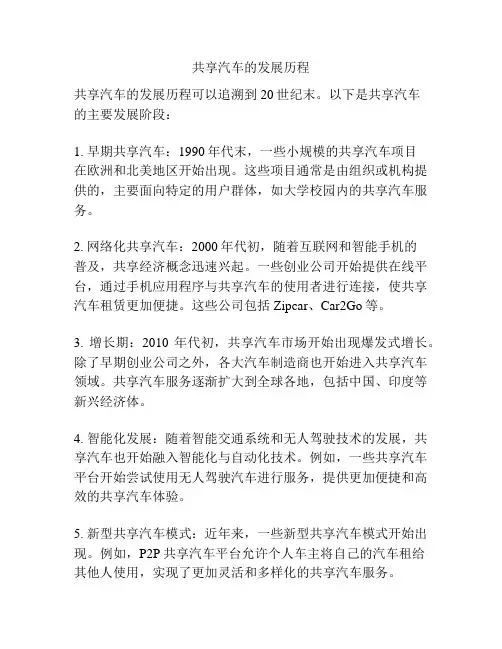
共享汽车的发展历程
共享汽车的发展历程可以追溯到20世纪末。
以下是共享汽车
的主要发展阶段:
1. 早期共享汽车:1990年代末,一些小规模的共享汽车项目
在欧洲和北美地区开始出现。
这些项目通常是由组织或机构提供的,主要面向特定的用户群体,如大学校园内的共享汽车服务。
2. 网络化共享汽车:2000年代初,随着互联网和智能手机的
普及,共享经济概念迅速兴起。
一些创业公司开始提供在线平台,通过手机应用程序与共享汽车的使用者进行连接,使共享汽车租赁更加便捷。
这些公司包括Zipcar、Car2Go等。
3. 增长期:2010年代初,共享汽车市场开始出现爆发式增长。
除了早期创业公司之外,各大汽车制造商也开始进入共享汽车领域。
共享汽车服务逐渐扩大到全球各地,包括中国、印度等新兴经济体。
4. 智能化发展:随着智能交通系统和无人驾驶技术的发展,共享汽车也开始融入智能化与自动化技术。
例如,一些共享汽车平台开始尝试使用无人驾驶汽车进行服务,提供更加便捷和高效的共享汽车体验。
5. 新型共享汽车模式:近年来,一些新型共享汽车模式开始出现。
例如,P2P共享汽车平台允许个人车主将自己的汽车租给
其他人使用,实现了更加灵活和多样化的共享汽车服务。
总体来说,共享汽车经历了从早期试点项目到爆发式增长的发展历程。
随着技术的进步和共享经济的发展,共享汽车有望在未来继续发展壮大。
2021考研英语词汇备考:car的中文解释备战考研英语,大众考生的第一反应便是从英语词汇入手。
记住学会一个单词不仅仅是拼写重点掌握的还有这个词的词性,各种语境下的语义。
老师分享2021考研英语词汇备考:car的中文解释内容,希望能给备战2021考研考生提供帮助~car的中文解释名词1.汽车,轿车2.(火车)车厢3.车辆;有轨电车4.[英国方言]任何有轮的车(如运货马车、农用马车)5.[美国英语](电梯的)升降室6.(气球等的)吊舱,吊篮单词分析这些名词都与车有关。
car多指乘坐人的小汽车或轿车。
bus一般指公共汽车或大型客车。
truck与lorry同义,都指卡车或货车,前者为美国用词,后者用于英国。
coach原义指四轮马车,现指轿式汽车,长途公共汽车,还可指火车设有卧铺的车厢。
automobile是汽车的总称。
jeep吉普车,指一种小型轻便、适合在崎岖路面或野外使用的车子。
carriage指马车,两匹或两匹以上马拉的四轮马。
waggon指四轮运货马车或牛车,也指铁路的无盖货车。
英语解释a motor vehicle with four wheels; usually propelled by an internal combustion enginea wheeled vehicle adapted to the rails of railroadwhere passengers ride up and downthe compartment that is suspended from an airship and that carries personnel and the cargo and the power planta conveyance for passengers or freight on a cable railway例句His was a most remarkable career, and I have thought that its history would make a valuable addition to our biographical literature他所经历的是最不平凡的一生,我认为他的历史将给传记文学增添光彩。
共享汽车英语作文Carsharing is a cool and convenient way to get aroundin the city. It's perfect for those days when you don'twant to deal with the hassle of owning a car but still need to get somewhere. Plus, it's eco-friendly and helps reduce traffic congestion.With carsharing, you don't have to worry about payingfor parking or maintaining a vehicle. You just hop in,drive to your destination, and then leave it for the next person to use. It's like having a car when you need it and not having to worry about it when you don't.Another great thing about carsharing is that it gives you access to different types of vehicles. Whether you need a small car for a quick trip or a larger SUV for a family outing, there's usually a variety of options to choose from. Plus, you can often rent electric cars, which are great for reducing your carbon footprint.I also love that carsharing apps make it so easy tofind and book a car. You can usually see where theavailable cars are located on a map and book one in just a few clicks. It's super convenient and saves a lot of time compared to traditional car rental services.Overall, carsharing is a great option for anyone who wants to save money, reduce their environmental impact, and still have the freedom to get around the city. It's definitely worth checking out if you haven't tried it yet!。
carsharing英文作文下载温馨提示:该文档是我店铺精心编制而成,希望大家下载以后,能够帮助大家解决实际的问题。
文档下载后可定制随意修改,请根据实际需要进行相应的调整和使用,谢谢!并且,本店铺为大家提供各种各样类型的实用资料,如教育随笔、日记赏析、句子摘抄、古诗大全、经典美文、话题作文、工作总结、词语解析、文案摘录、其他资料等等,如想了解不同资料格式和写法,敬请关注!Download tips: This document is carefully compiled by theeditor. I hope that after you download them,they can help yousolve practical problems. The document can be customized andmodified after downloading,please adjust and use it according toactual needs, thank you!In addition, our shop provides you with various types ofpractical materials,such as educational essays, diaryappreciation,sentence excerpts,ancient poems,classic articles,topic composition,work summary,word parsing,copyexcerpts,other materials and so on,want to know different data formats andwriting methods,please pay attention!Carsharing is a great way to save money and reduce your carbon footprint. It's like renting a car, but with more flexibility. You can use a car for just a few hours or a whole day, and you only pay for the time you use it. Plus, carsharing companies often have a variety of vehicles to choose from, so you can pick the right car for your needs.One of the best things about carsharing is that youdon't have to worry about maintenance or repairs. The carsharing company takes care of all of that for you. So, you can just enjoy the convenience of having a car when you need it, without any of the hassle of owning one.Carsharing is also a great option for people who don't need a car very often. Instead of paying for a car thatsits unused most of the time, you can just use a carsharing service when you need it. This can save you a lot of money in the long run, especially if you live in a city where owning a car can be expensive.Another benefit of carsharing is that it can help reduce traffic and parking problems in cities. When more people use carsharing, there are fewer cars on the road, which means less congestion and pollution. Plus, carsharing companies often have designated parking spots, so you don't have to worry about finding a place to park.Overall, carsharing is a convenient, cost-effective, and eco-friendly way to get around. Whether you need a car for a quick errand or a weekend getaway, carsharing has you covered. So, next time you need a car, consider giving carsharing a try. You might be surprised at how much you like it.。
中国的共享出行英文作文英文回答:Shared Mobility in China。
Shared mobility has emerged as a rapidly growing trendin China, offering a convenient and sustainable alternative to traditional modes of transportation. It encompasses a wide range of services, including bike-sharing, car-sharing, and ride-hailing, which have gained immense popularity both in urban and rural areas.Evolution and Growth。
China's shared mobility sector has evolvedsignificantly over the past decade. In the early 2010s,bike-sharing emerged as a dominant force, with several companies such as Mobike and Ofo launching their servicesin major cities. These companies offered affordable and accessible transportation options, especially for short-distance travel.Later, car-sharing and ride-hailing services gained traction. Car-sharing companies like Car2Go and eHi Car Services allowed users to rent vehicles on an hourly or daily basis, providing flexibility and convenience. Ride-hailing platforms such as Didi and T3 Go allowed users to book rides with private drivers, offering a premium and convenient transportation experience.Factors Contributing to Growth。
Car sharing has become an increasingly popular mode of transportation in urban areas,offering a convenient and costeffective alternative to owning a personal vehicle. Heres an essay on the topic of car sharing in English:The Rise of Car Sharing:A Sustainable Urban Mobility SolutionIn the heart of bustling cities,the concept of car sharing has taken root and flourished, providing a greener and more efficient way to navigate the urban landscape.The traditional model of car ownership,with its associated costs and environmental impacts, is being challenged by this innovative approach to transportation.The Benefits of Car Sharing1.CostEffectiveness:Car sharing services allow users to pay only for the time they use the vehicle,eliminating the need for costly monthly payments,insurance,and maintenance fees associated with owning a car.2.Environmental Impact:By reducing the number of cars on the road,car sharing contributes to a decrease in carbon emissions and traffic congestion.It encourages the use of fewer vehicles,which in turn reduces pollution.3.Accessibility:For those who live in densely populated areas where parking is scarce or expensive,car sharing offers a practical ers can access a car when needed without the hassle of finding a parking spot.4.Technological Integration:Modern car sharing services are often integrated with smartphone apps,making it easy to locate,reserve,and unlock vehicles,enhancing the user experience.How Car Sharing WorksCar sharing services typically operate on a membership ers sign up,often through an app,and can then reserve a vehicle for a specific period.The process is streamlined,with payment handled digitally,and the vehicles are often equipped with technology to facilitate easy access and return.Challenges Faced by Car SharingDespite its many advantages,car sharing also faces challenges:1.Infrastructure Requirements:Adequate parking spaces and charging stations for electric vehicles need to be available to support car sharing services.2.Regulatory Issues:Different cities have different regulations regarding car sharing, which can affect the scalability and uniformity of services.3.Cultural Shift:There is a need for a cultural shift in attitudes towards car ownership, with more people needing to embrace the idea of shared resources.The Future of Car SharingAs urban populations continue to grow and the need for sustainable transportation solutions becomes more pressing,car sharing is poised to play a significant role in the future of urban mobility.With advancements in technology and increasing environmental awareness,it is likely that car sharing will continue to evolve and expand,offering more options and convenience to city dwellers.In conclusion,car sharing represents a forwardthinking approach to urban transportation. It not only addresses the practical concerns of city living but also aligns with the global push towards sustainability and reduced environmental impact.As the world moves towards more integrated and efficient systems of mobility,car sharing is set to become an integral part of the urban fabric.。
一篇对比作文50字Car ownership provides convenience and independence for individuals. 车辆拥有权为个人提供了便利和独立性。
However, it also contributes to traffic congestion and air pollution. 但是,它也导致了交通拥堵和空气污染。
Alternatives such as public transportation and car-sharing services offer more sustainable and efficient solutions. 公共交通和共享汽车等替代方案提供了更可持续和高效的解决方案。
While owning a car may give a sense of status, it does come with a hefty price tag. 拥有一辆汽车可能会给人一种身份地位的感觉,但也伴随着高昂的价格。
In contrast, using alternative modes of transportation can be more cost-effective in the long run. 相比之下,利用替代交通方式在长期来看更具成本效益。
Driving a car offers flexibility and convenience in terms of travel time and destination. 开车在旅行时间和目的地方面提供了灵活性和便利性。
However, it also requires the responsibility of maintenance, parking, and insurance. 但是,这也需要负担维护、停车和保险的责任。
On the other hand, utilizing public transportation or car-sharing services may limit one's freedom but relieve them of the burdens of ownership. 另一方面,利用公共交通或共享汽车服务可能会限制个人的自由,但也减轻了拥有车辆所带来的负担。
共享汽车car-sharing
New energy vehicle-sharing projects are being carried out in dozens of cities across the country, such as Beijing, Shanghai, Chengdu and Shenzhen. The new type of service is expected to fuel China's sharing economy in the next few years.
新能源汽车共享项目已在北京、上海、成都和深圳等多个城市展开。
这种新型的服务有望在未来几年为我国分享经济注入发展动力。
汽车共享/共享汽车(car-sharing)服务在国内的早期经营模式是通过租车行提供车辆租赁服务(car rental),后来,民间开始出现个人拼车(car pooling)行为,单独开车出行的个人找几个出行路线相同的人乘车,这几个人分担部分车辆开支,这样的形式在移动网络普及以后就发展成了“顺风车”(ride sharing)服务。
如今,这几个城市推出的共享汽车服务应该算是汽车租赁服务的移动互联网版本,运营模式参照大家已经熟悉的共享单车服务(bicycle-sharing)。
据了解,要享受共享汽车首先要下载客户端,然后注册会员,上传本人身份证和驾照实物照片(users are required to submit their ID information and a photo of their driver’s license),经审核通过并交纳押金(de p osit)后,即可通过扫描二维码使用分时租车服务。
据调查,各家共享汽车公司押金标准不一,比如一度用车不需要押金、有的需要交纳1800元押金,而Gofun汽车的会员押金为699元。
这些押金主要的用途是用于车辆损坏(car damage)、违章(traffic violation)以及发生行政处罚所产生费用后,用户不按时承担相应责任,公司有权从押金中扣除相应费用。
在租车费用方面,据客服介绍,计费包括实际里程费+实际用车时间(分钟),即1元钱1公里+1毛钱1分钟。
以50公里路程为例,如果用半个小时跑下来,租车费用为1元*50公里+0.1元*30分钟=53元。
【名词解释】
分享经济(sharing economy或shared economy)指能够让商品、服务、数据以及才能等有共享渠道的经济社会体系。
这些体系形式各异,但都是运用信息技术让个人、公司、非盈利机构以及政府掌握大量信息以让他们可以分配、共享及再利用过剩的商品和服务。
该体系的共同前提是,有关商品的信息被共享以后,该商品对商家、个人以及社区的价值也随之增加。